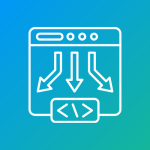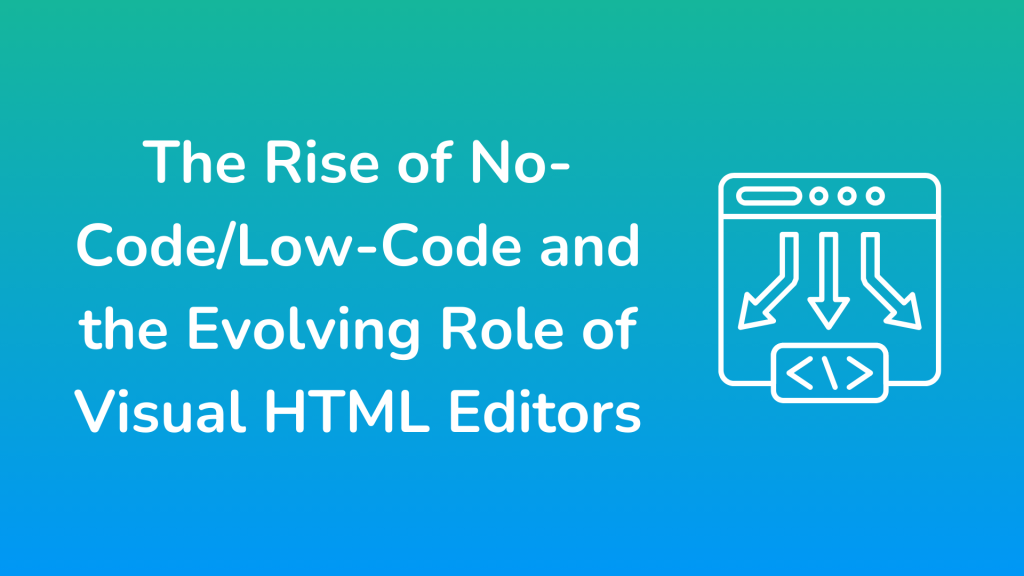The Rise of No-Code/Low-Code and the Evolving Role of Visual HTML Editors
- Posted on
- By Rimsha Ashraf
- In General,
Table of contents
- What is Low-Code Development?
- What is No-Code Development?
- Why Are No-Code and Low-Code Techniques Gaining Popularity?
- Benefits of NLC for Non-Technical Users
- The Possible Difficulties of Low-Code/No-Code
- Streamlining Workflows: The Power of a Visual HTML Editor
- Froala: Bridging the Gap between NLC and Visual Editing
- Conclusion

The digital landscape is seeing substantial changes. The development of visual HTML editors and the increasing number of no-code/low-code (NLC) platforms drive this trend.
These advancements democratize web development. They make it accessible to more people, from beginners to seasoned developers.
This article explores the growing influence of No-Code/Low-Code and visual HTML editors. It shows how they empower non-technical users and help experienced developers.
What is Low-Code Development?
Low-code development is a type of software development. It emphasizes visual, declarative techniques to cut the amount of hand-coding needed.
Unlike traditional coding, where developers write every line of code, low-code platforms provide tools and components. They let developers design, build, and deploy apps with less manual coding.
Low-code platforms still need coding expertise. But, they make software development much easier by using visual modeling, drag-and-drop interfaces, and pre-built templates.
This lets developers create apps. Developers often use low-code development for speed, flexibility, and ease of use. They do this in fast-changing business environments or when making prototype applications for testing.
What is No-Code Development?
No-code development revolutionizes software creation. It lets users build applications without writing code. People can design, develop, and deploy software solutions without deep coding knowledge. They do this through easy visual interfaces and drag-and-drop tools.
These platforms offer many features. These include pre-built templates, integration with third-party services, and automated deployment.
No-code development abstracts complexities and lowers entry barriers. It democratizes software creation and empowers people and teams with diverse skills. This approach is often used for prototyping, iterating on applications, automating business processes, and creating mobile apps.
No-code development fosters innovation and collaboration. It drives faster time-to-market and speeds up digital change in industries.
Why Are No-Code and Low-Code Techniques Gaining Popularity?
Website development has always been limited to highly qualified programmers. Yet, the Low code/no code revolution is changing this paradigm. Following are the reasons these approaches are gaining popularity.
- Enhanced productivity: Using low code/no code platforms cuts development time and expenses a lot. Instead of mundane, repetitive code, developers may work on higher-level tasks.
- Building capacity for citizen developers: Business customers are given the power to manage their applications using no-code platforms. This change speeds up application delivery while reducing the workload for IT teams.
- Bridging the skill gap: You can fill the skill gap using low-code and no-code approaches. Few people have coding skills. In a world with few of them, the ability to make helpful software is invaluable. You can do this without much experience.
- Fast prototyping: These platforms are perfect for iterating and prototyping. Without knowing how to code, you can develop a working prototype in no time and then iterate based on user input.
- Digital agility: Being nimble is key in today’s fast-paced corporate world. Organizations respond to changing markets. They can do this because of low-code and no-code platforms.
Benefits of NLC for Non-Technical Users
There are several advantages to no-/low-coding (NLC) for non-technical users:
- Less dependence on IT: NLC platforms let business users create basic apps on their own, which eases the load on IT teams and speeds up project schedules.
- Better communication and teamwork: NLC helps non-technical stakeholders and developers work together more closely by making it easier for them to see and test their ideas.
- Quicker concept validation and feedback collection: NLC platforms support rapid prototype and Minimum Viable Product generation, allowing for faster idea validation and feedback collection.
The Possible Difficulties of Low-Code/No-Code
Despite their many benefits, not every project is a good fit for low-code or no-code platforms. Some things to think about are:
- Depth: Some complicated applications may necessitate bespoke code for optimum efficiency.
- Scalability: Checking if the platform can manage the project’s demands is critical for large-scale applications.
- Vendor lock-in: You may need to determine whether the platform allows access to vendor-specific technology or if it might lead to vendor lock-in
Streamlining Workflows: The Power of a Visual HTML Editor
While NLC platforms cater to non-coders, a visual HTML editor is also transforming the experience for developers. Real-time visualization and a drag-and-drop interface provide these editors with how programmers can construct complex web pages and applications visually.
<!-- Example of a visual HTML editor interface --> <div id="visual-editor"> <!-- Visual representation of a web page with drag-and-drop functionality --> <div class="page-container"> <!-- Drag-and-drop elements for building the page --> <div class="element draggable" data-element="text">Text</div> <div class="element draggable" data-element="image">Image</div> <div class="element draggable" data-element="button">Button</div> <!-- Other draggable elements --> </div> <!-- Preview pane for real-time visualization --> <div class="preview-pane"> <!-- Preview of the constructed web page --> </div> </div>
This process effectively diminishes the duration devoted to code creation, thereby enabling developers to allocate their attention toward more strategic elements such as functionality and logic.
Advantages for developers of visual HTML editors include:
- Productivity enhancement: The use of visual editors removes the necessity for manual code composition, resulting in expedited development cycles and heightened efficacy.
- Enhanced collaboration: A visual HTML editor provides developers and designers with a shared platform, enabling smooth communication and guaranteeing the integrity of the design in the ultimate deliverable.
- Decreased coding error: Visual editors frequently incorporate validation and error-checking functionalities, thereby mitigating the potential for human errors to occur in the code.
Froala: Bridging the Gap between NLC and Visual Editing
Froala stands out as a unique platform that bridges the gap between NLC and visual editing. It offers a flexible solution that caters to both non-technical users and developers.
For non-coders, Froala provides:
- Simple to use, drag-and-drop interface: Users can quickly and simply construct websites and apps by arranging pre-made elements.
- Various widgets and templates: Froala provides a large library of pre-designed components for a head start on development and consistency.
- WYSIWYG: This allows users to see their contributions come to life in real time, providing a more user-friendly experience.
For developers, Froala offers:
- Advanced code editing capabilities: Developers can access and change the underlying code. They can do this for complete control and customization.
- It integrates with popular frameworks: These include React, Angular, and Vue.js. This lets developers use their existing skills.
- Open-source options: Froala offers commercial and open-source versions. It serves diverse needs and budgets.
Froala offers a hybrid approach. It empowers non-technical users and developers. They can contribute to web development. This fosters collaboration, innovation, and efficiency. It leads to the creation of great digital experiences.
Conclusion
The rise of NLC and visual HTML editors shows a shift. It is toward a more collaborative web development landscape. These advancements empower people with different skills. They can use them to create digital products. This enables more creativity and agility.
As the tech landscape evolves, we expect to see more seamless integration. It will be between NLC and visual editing tools. This will further democratize web development and make it accessible to everyone.
Rimsha Ashraf
Rimsha Ashrafa writer for Froala, showcasing exceptional talent and dedication.
-
Hide Show






No comment yet, add your voice below!